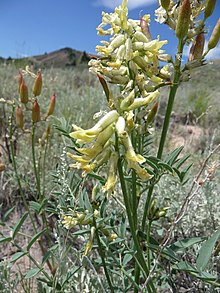Astragalus scaphoides, the bitterroot milkvetch, is a flowering plant in the family Fabaceae, the third-largest plant family in the world.[3] It is found only in a small area of southwest Montana and adjacent parts of Idaho. It grows on shallow, south-facing slopes, in semi-arid sage scrub.
| Bitterroot milkvetch | |
|---|---|

| |
| Scientific classification | |
| Kingdom: | Plantae |
| Clade: | Tracheophytes |
| Clade: | Angiosperms |
| Clade: | Eudicots |
| Clade: | Rosids |
| Order: | Fabales |
| Family: | Fabaceae |
| Subfamily: | Faboideae |
| Genus: | Astragalus |
| Species: | A. scaphoides
|
| Binomial name | |
| Astragalus scaphoides (M.E. Jones) Rydb.
| |
Astragalus scaphoides is a perennial herbaceous plant, with pinnate leaves. The pale yellow flowers open in May and are visited by several species of bumblebees and solitary bees, including species from the genera Osmia and Anthophora.
Plants can be found near Lemhi Pass on the Montana-Idaho border, and near Bannack State Park in Montana.
Plants tend to flower in alternate years,[4] similar to mast years in grasses and trees.
References edit
- ^ "NatureServe Explorer Astragalus scaphoides". NatureServe Explorer Astragalus scaphoides. Arlington Virginia, United States of America: NatureServe. 2022-06-03. NatureServe Element Code:PDFAB0F7V0. Retrieved 23 Jun 2022.
- ^ Faber-Langendoen, D; Nichols, J; Master, L; Snow, K; Tomaino, A; Bittman, R; Hammerson, G; Heidel, B; Ramsay, L; Teucher, A; Young, B (2012). NatureServe Conservation Status Assessments: Methodology for Assigning Ranks (PDF) (Report). Arlington, Virginia, United States of America: NatureServe.
- ^ "Society for the Study of Evolution", Wikipedia, 2019-01-17, retrieved 2020-04-25
- ^ Gurevitch, J., S. M. Scheiner, and G. A. Fox. The Ecology of Plants, Second Edition. Sinauer Associates, Inc., Sunderland MA USA
External links edit
